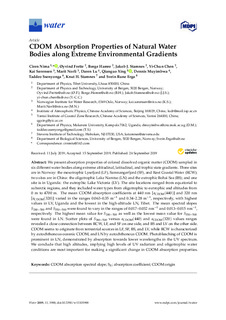| dc.description.abstract | We present absorption properties of colored dissolved organic matter (CDOM) sampled in six different water bodies along extreme altitudinal, latitudinal, and trophic state gradients. Three sites are in Norway: the mesotrophic Lysefjord (LF), Samnangerfjord (SF), and Røst Coastal Water (RCW); two sites are in China: the oligotrophic Lake Namtso (LN) and the eutrophic Bohai Sea (BS); and one site is in Uganda: the eutrophic Lake Victoria (LV). The site locations ranged from equatorial to subarctic regions, and they included water types from oligotrophic to eutrophic and altitudes from 0 m to 4700 m. The mean CDOM absorption coefficients at 440 nm [ a CDOM (440) aCDOM(440) ] and 320 nm [ a CDOM (320) aCDOM(320) ] varied in the ranges 0.063–0.35 m −1 −1 and 0.34–2.28 m −1 −1 , respectively, with highest values in LV, Uganda and the lowest in the high-altitude LN, Tibet. The mean spectral slopes S 280−500 S280−500 and S 350−500 S350−500 were found to vary in the ranges of 0.017–0.032 nm −1 −1 and 0.013–0.015 nm −1 −1 , respectively. The highest mean value for S 280−500 S280−500 as well as the lowest mean value for S 350−500 S350−500 were found in LN. Scatter plots of S 280−500 S280−500 versus a CDOM (440) aCDOM(440) and a CDOM (320) aCDOM(320) values ranges revealed a close connection between RCW, LF, and SF on one side, and BS and LV on the other side. CDOM seems to originate from terrestrial sources in LF, SF, BS, and LV, while RCW is characterized by autochthonous-oceanic CDOM, and LN by autochthonous CDOM. Photobleaching of CDOM is prominent in LN, demonstrated by absorption towards lower wavelengths in the UV spectrum. We conclude that high altitudes, implying high levels of UV radiation and oligotrophic water conditions are most important for making a significant change in CDOM absorption properties. | nb_NO |

